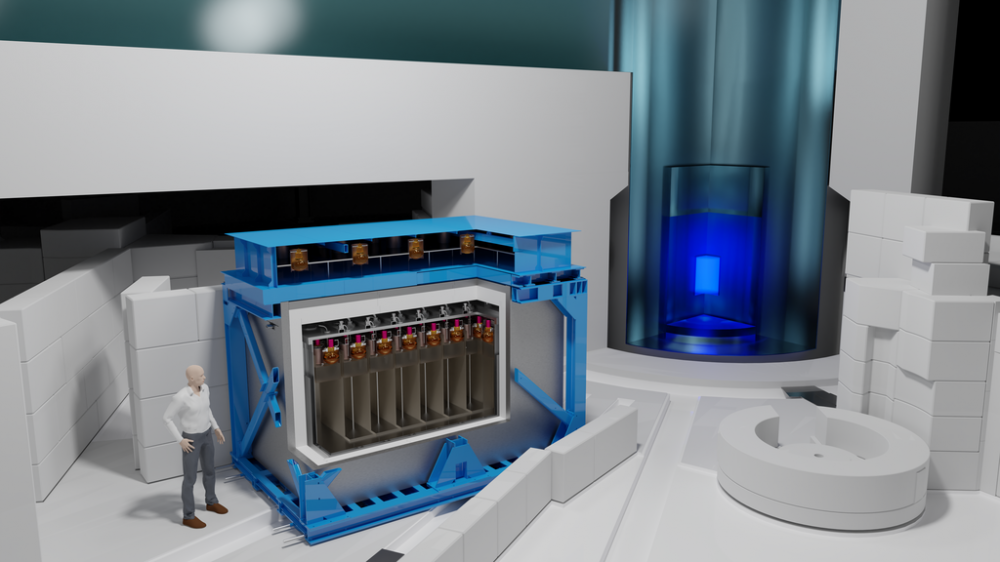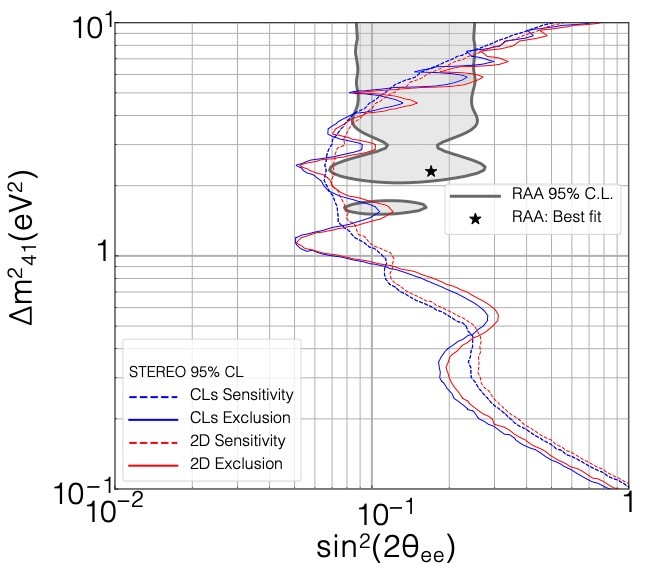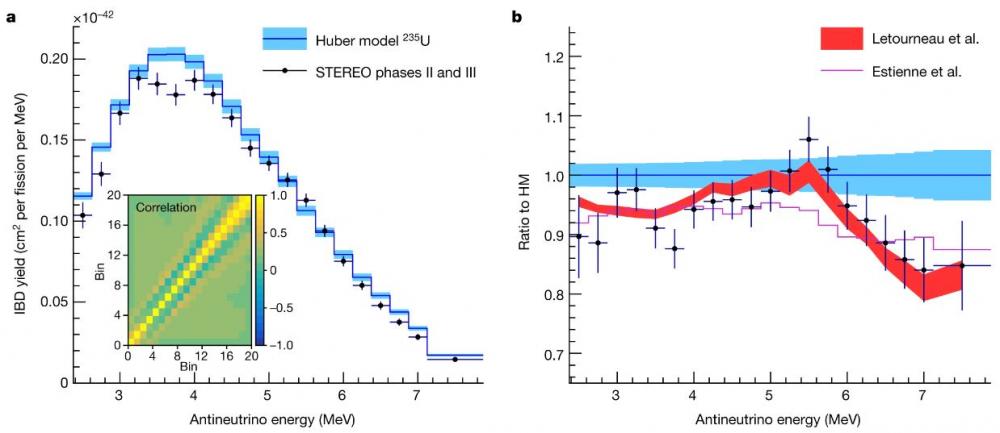
Figure 1: Illustration of the Stereo experiment by Loris Scola. The cross-section of the detector shows the different layers of shielding put in place to attenuate the external background. The detector core is made of 6 identical cells placed between 9 and 11 m from the ILL compact core, visible here by the intense Cerenkov light it induces in the water of the reactor pool. Neutrino interactions induce tiny flashes of light in the liquid scintillator that fills the cells, whose reflective walls collect the light to photomultipliers installed at the top. Above Stereo a large channel, filled with 6 m of water and connected to the pool, offers a crucial protection against cosmic rays.
The final results of the Stereo experiment have just been published in the journal Nature. A record of precision is established for the spectrum of neutrinos emitted by the fission of 235U, measured between 9 and 11m distance from the ILL reactor core in Grenoble. The hypothesis of a sterile neutrino to explain the reactor neutrino anomaly is rejected. The quality of these direct neutrino measurements now surpasses that of the underlying nuclear data describing the beta decays of fission products. Stereo provides the community with a fission neutrino spectrum corrected for all detection effects, which will serve as a reference for future reactor experiments and points out residual biases in the nuclear databases.
The Stereo experiment has just completed a beautiful scientific adventure that began in 2011 with the revelation by the IRFU group of the "reactor antineutrino anomaly". Physicists were left with a significant deficit of 6% between the flux of neutrinos measured at the reactors and the predicted flux. The history of science has taught us enough about the potential richness of new phenomena that can hide behind an anomaly. What was going on here was the possible existence of a new type of neutrino that would open up a new area of physics beyond the standard model. Without any direct interaction with matter, this neutrino, described as "sterile", could however mix with "standard" neutrinos and thus leave an imprint of its existence through ... a deficit of count rate in our detectors.
A few years later, experiments with commercial reactors measuring the mixing angle θ13 revealed a second anomaly, this time a distortion in the shape of the spectrum. Obviously, nothing was going well in the prediction of reactor neutrino spectra. The community then embarked on an experimental program of precision measurements to clear this up. Stereo took the option of setting up at the ILL research reactor in Grenoble. Its very compact core (<1m) is well suited to the test of the hypothetical mixing of sterile and standard neutrinos, which would manifest itself by oscillations of the count rates as a function of energy but also of the distance to the core, with a short wavelength of typically 1 to 10 m. Since the ILL fuel is highly enriched in 235U, the fissions come only from this isotope, whereas in commercial reactors they are distributed between the isotopes of uranium and plutonium, with contributions that vary during a cycle. Finally, Stereo benefits from the know-how acquired over several generations of experiments that have given great maturity to the detection of neutrinos in liquid scintillators.
Installed at only 10 m from the reactor core (see figure 1), Stereo has detected some 107558 neutrinos during the 4 years of data taking between 2017 and 2020. This is quite an achievement considering the difficulty to intercept these ghostly particles and the difficulty to fight the strong background induced by the neutron beams feeding the other experiments in the ILL hall and by the cosmic rays showering the earth surface.

Figure 2: The mixing of reactor neutrinos with a hypothetical sterile neutrino is shown in the plane of the two variables of interest: the oscillation amplitude (horizontal axis) and the oscillation frequency (vertical axis). To explain the reactor neutrino deficit by a sterile neutrino it would have been necessary that the oscillation parameters are in the grey area. Stereo does not detect an oscillation signal, the data exclude the whole area to the right of the blue or red curves with 95% confidence. The majority of the gray area is therefore rejected, the remaining part at very high frequency being constrained by other measurements. The two colors red and blue correspond to different statistical analysis methods, in good agreement with each other. The dotted curves show the sensitivity predicted by the detector simulations. If the simulation is correct, the "real data" should lead to a contour that navigates around the sensitivity curve, which is indeed the case.
Another essential quality of the experiment was to control the detector response at the % level during this whole period. In the end, Stereo's contract is fulfilled beyond expectations. By comparing the neutrino spectra detected in the 6 cells of the target volume it was possible to test whether or not oscillations with a sterile neutrino exist. This analysis is based only on the relative deviations between the 6 identical cells, so it is independent of any possible bias in the prediction of the expected spectrum. The 6 spectra are found to be perfectly compatible with each other and the precision of the measurements allows to reject the hypothesis of a sterile neutrino (figure 2). “Standardness” remains the rule...
But by cumulating all the events of the target volume we also establish a record of precision for the neutrino spectrum of the 235U fission, both for its absolute normalization and for its shape. This spectrum is still seen through Stereo's "eyes", i.e. it is affected by the resolution and non-linearity effects that are inherent to the detector, but we have shown that all these distortions are perfectly described by the simulation of the experiment. A precise deconvolution procedure could then be developed to correct all detection effects and provide a reference neutrino spectrum, as a function of the true energy of the neutrinos and not on the energy reconstructed by the detector (figure 3a). This new reference is available online and can be used by everyone.
The interest of these measurements radiates beyond the neutrino community: Stereo confirms that there is indeed a deficit and a distortion in shape between the measurement and the prediction of the neutrino spectrum of the 235U fission (figure 3b) and the interpretation of these "reactor anomalies" now points to biases in the nuclear data. We are thus witnessing a paradigm shift: after decades during which nuclear physics fed fundamental neutrino physics, it is the accuracy of neutrino measurements such as Stereo that is now challenging the quality of nuclear data.

Figure 3: a) Neutrino spectrum of 235U fission measured by Stereo. The blue band represents the prediction (the "Huber-Mueller" model) and its uncertainty. b) The deviation from this prediction clearly shows the two anomalies: a global deficit, with a distortion in shape. The purple curve is a new prediction using recent measurements to correct the beta spectra of the main fission products contributing to the neutrino spectrum. Most of the deficit is then corrected. The red curve is a model developed at IRFU which applies a simple effective correction of the beta spectra to all fission products. A very good agreement with the Stereo data is then obtained.
Thus the Stereo adventure closes the loop around the reactor neutrino anomalies. By making a reference measurement of the neutrino spectrum from 235U fission, it rejects the sterile neutrino hypothesis and provides a solid basis for future generations of experiments. In doing so, many nuclear data directly connected to the accuracy of this measurement have been scrutinized. Unexpectedly, a key element for the % control of the detector response has been the collaboration with the developers of the Fifrelin code to improve the description of the gamma-ray decay cascades of the nuclei. This collaboration is still active and leads today to an original method of calibration of the bolometers, for the next experiments of search for dark matter and detection of the coherent scattering of neutrinos. Finally, the agreement of the predictions with the Stereo data highlights the biases present in the current description of the beta spectra by the nuclear databases. A large program of re-evaluation of these spectra is underway with direct applications for the nuclear energy sector.
• Structure of nuclear matter › Nuclear reaction dynamics The ultimate constituents of matter › Neutrino Physics
• The Nuclear Physics Division • The Particle Physics Division
• LEARN - Study and Applications of Nuclear Reactions • Sources and reactors neutrinos
• STEREO



